The SSD 730 Series Review: Intel Is Back With Its Own Controller
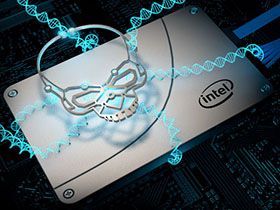
Meet Intel's SSD 730 Series Drive
Intel's old school X25-M SSDs leveraged the company's 50 nm flash and a controller designed in-house. That once-bleeding-edge SATA 3Gb/s-capable processor could be equipped with up to 10 channels of memory, which helped bolster its performance and potential capacity. Although the silicon went on to be revised for other applications, we as enthusiasts held a soft spot in our hearts for it, even as faster and less expensive competition rose to challenge Intel.
Initially, the advent of SATA 6Gb/s saw Intel left behind, though a tryst with Marvell's 9175 controller, followed by a SandForce partnership, at least kept the company visible.
Then, a little over a year ago, another proprietary processor surfaced in the SSD DC S3700 (Intel SSD DC S3700 Review: Benchmarking Consistency). We suspected, however, that we weren't going to see that controller in a mainstream, client-oriented drive. It was purpose-built for the rigors of enterprise deployment, and emphasized different strengths than what you typically find on the desktop. Nevertheless, we asked if the new chip would one day surface in that space, and were told it'd be a question of resources. Since Intel was being serviced by its solid LSI SandForce partnership, we figured it'd be a while.
The time has come, though. We finally have another modern consumer-oriented drive with an Intel controller. Dubbed the SSD 730 Series, it leverages the same platform as the company's SSD DC S3700 and S3500.
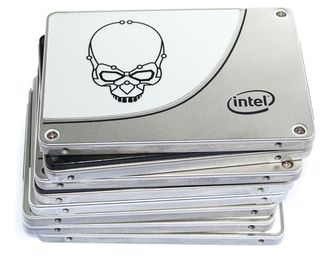
We're told that SSD 730 drives will cost somewhere around $1/GB, which means it won't be competing aggressively against some of our favorite alternatives in a value comparison. It should be able to deliver strong performance, though. This is a prosumer product, aimed at professionals who remember Intel's commitment to speed and reliability from the generation prior.
| Intel SSD 730 Series | 240 GB | 480 GB |
|---|---|---|
| Controller | Intel PC29AS21CA0 | |
| NAND | 20 nm IMFT , 64 Gb Die | |
| Sequential Read / Write | 550 / 270 MB/s | 550 / 470 MB/s |
| Random 4 KB Read / Write | 86,000 / 56,000 IOPS | 89,000 / 74,000 IOPS |
| Endurance | 50 GB writes/day | 70 GB writes/day |
| Form Factor | 7 mm, 2.5" SATA | |
| Warranty | Five years |
Intel is introducing two capacities, 240 and 480 GB, though there's no reason the company couldn't also cook up a 960 GB model down the road.
So, the nuts and bolts include Intel's eight-channel controller, the company's special stash of 20 nm NAND, and 1 GB of DDR3-1600 cache. That's fairly similar to the SSD DC S3500, which we looked at in The SSD DC S3500 Review: Intel's 6 Gb/s Controller And 20 nm NAND.
Stay On the Cutting Edge: Get the Tom's Hardware Newsletter
Get Tom's Hardware's best news and in-depth reviews, straight to your inbox.
Intel makes some very specific tweaks to this implementation, though. As OCZ discovered early on, a hotter controller can affect performance results. Intel took that information to heart and showed off an experimental SSD with parameters that could be user-modified (overclocked, if you will). But somewhere along the line, the company chose not to move forward with a tunable drive aimed at enthusiasts. Instead, turns the knobs for you. The SSD 730's controller runs 50% faster, with a 600 MHz clock rate, rather than 400 MHz. Also, its NAND interface is sped from 83 to 100 MHz. "Factory-overclocked", company reps call this. The marketing there is questionable.
The SSD 730 does include some interesting features to help make up for the emotional letdown. There are no hardware-accelerated encryption capabilities to speak of. Instead, you get better endurance ratings than most client-oriented SSDs can offer, along with power-loss protection courtesy of electrolytic capacitors soldered onto the PCB. Intel positions the SSD 730 as a RAID-ready device, diminishing the utility of on-drive encryption; a proper RAID controller should handle that. The capacitors are more interesting and useful, particularly in multi-drive setups.
Oh, and the SSD 730 gets a boss skull logo on the chassis, just like some of Intel's other enthusiast products. Enough talk. Let's open this thing up.
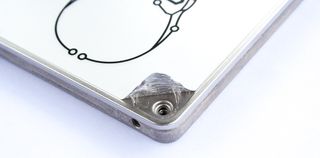
You'll have to deface the skull sticker to reach a hidden screw. From there, the top pops right off.
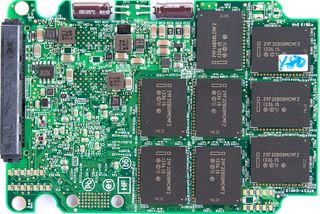
Right from the start, our analysis gets complicated. Most NAND packages are 29F32B08MCMF2 (14 x 32 GiB), but there's also a 29F64B08NCMF2 (1 x 64 GiB) and a 29F16B08LCMF2 (1 x 16 GiB). That means you get 528 GiB, or 566 GB of raw flash. This extra space is used for a parity-based redundancy system able to recover from a partial die failure.

Up top you see the SSD 730 Series' power-loss protection mechanism, two 105 °C-rated 47 μF capacitors. Below that are the two 512 MB DDR3-1600 DRAM packages.
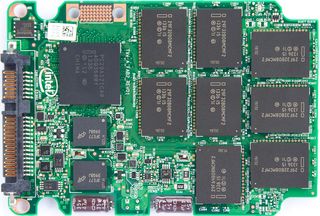
The back of the PCB hosts the other eight NAND packages, both DRAM placements, and the Intel PC29AS21CA0 controller running at 600 MHz.
Current page: Meet Intel's SSD 730 Series Drive
Next Page Test Setup And Benchmarks-
blackmagnum That skull on an Intel SSD means this product is the Big Kahuna. Samsung just cannot crush this competition.Reply -
Amdlova that 480 drain more than a 5400rpm HDD. Samsung or sandisk for laptops. Please next SSDReply -
rokit Never expected Intel to fail like that. Samsung still offers the best performance/power consumption/$Reply
I guess that skull did the job, power of signs )
p.s. this site has level editing in non-forum mode(the one you see and use by default)
Watch the language. - G -
mamasan2000 I don't see why the Intel SSD is any good. It's midpack at best at everything. Even my cheap Sandisk is better and it was the cheapest SSD I could get around here (besides Kingston).Reply -
unityole how is samsung the best? http://www.tweaktown.com/blogs/Chris_Ramseyer/58/real-world-ssd-performance-why-time-matters-when-testing/index.htmlsandisk and toshiba SSD, look at the chart and see the performance for yourself. Evo doing well, but thats only cause of the SLC flash helping it.Reply -
eriko All this Samsung love here... I have two brand new 840 Evo 250GB drives, and they are garbage.In fact they are so poor, I had to separate all my files, and break the RAID,and have two individual volumes, so as to have Trim enabled, and also Magician running, otherwise, terrible read and write (especially) performance resulted. I did verify they were genuine drives too. As soon as you begin to fill up these 250GB Evos, performance falls off a cliff.I'm now not a believer in TLC, and wish I had waited to get the Pro's (not available in this part of the world), as I hear much better things about them.But I've had my fill of reading reviews on consumer drives, I'm going to California in a week or so, and so I will either get 2 x 400GB S3700's, or a single 800GB S3700 (and to hell with RAID). Enterprise drives are the bomb, and don't forget that. Lost way too much time and data now with 'consumer' drives...By the way, X25E 64GB still going strong without so much as a hiccup. Not even a burp... If they made a 640GB X25E, I think I'd suck their, ok, I won't say that but you get the idea.Reply -
zzzaac Just curious, this speed, would you be able to tell that it is faster, or is it just though benchmarks?.This ssd is quite expensive at my local parts shopReply
Most Popular

